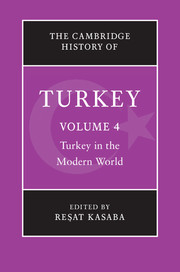Book contents
- Frontmatter
- 1 Introduction
- PART I OTTOMAN BACKGROUND AND TRANSITION
- PART II REPUBLIC OF TURKEY
- 7 Migration and Turkey: the dynamics of state, society and politics
- 8 The migration story of Turks in Germany: from the beginning to the end
- 9 Politics and political parties in Republican Turkey
- 10 Economic change in twentieth-century Turkey: is the glass more than half full?
- 11 Ideology, context and interest: the Turkish military
- 12 Kurds and the Turkish State
- 13 Islam and politics in contemporary Turkey
- 14 Sufism and Islamic groups in contemporary Turkey
- 15 Contestation and collaboration: women’s struggles for empowerment in Turkey
- 16 Art and architecture in modern Turkey: the Republican period
- 17 The novel in Turkish: narrative tradition to Nobel prize
- 18 A brief history of modern Istanbul
- Select bibliography
- Index
- References
12 - Kurds and the Turkish State
from PART II - REPUBLIC OF TURKEY
Published online by Cambridge University Press: 28 November 2009
- Frontmatter
- 1 Introduction
- PART I OTTOMAN BACKGROUND AND TRANSITION
- PART II REPUBLIC OF TURKEY
- 7 Migration and Turkey: the dynamics of state, society and politics
- 8 The migration story of Turks in Germany: from the beginning to the end
- 9 Politics and political parties in Republican Turkey
- 10 Economic change in twentieth-century Turkey: is the glass more than half full?
- 11 Ideology, context and interest: the Turkish military
- 12 Kurds and the Turkish State
- 13 Islam and politics in contemporary Turkey
- 14 Sufism and Islamic groups in contemporary Turkey
- 15 Contestation and collaboration: women’s struggles for empowerment in Turkey
- 16 Art and architecture in modern Turkey: the Republican period
- 17 The novel in Turkish: narrative tradition to Nobel prize
- 18 A brief history of modern Istanbul
- Select bibliography
- Index
- References
Summary
Together with the irtica (‘religious reaction’), the Kurdish question has constituted the most important challenge to the Turkish Republic since its foundation in 1923. The trajectory of the Kurdish issue has been determined by two features: the state’s denial of its existence; and the emergence of its radical challenge to the state. Official state policy either denied the very existence of a distinct group called Kurds, or presented the Kurds as a threat to Turkey and the Turks as a national entity. The Kurdish struggle, on the other hand, has been at the basis of a series of revolts between 1923 and 1938 and, later on, in the 1970s–1990s, of urban violence and guerrilla warfare.
Since the beginning of the Republic, there has always been a close link between Turkey’s internal Kurdish issue and the Kurdish conflict in the Middle East. Almost all the Kurdish struggles throughout the twentieth century have in fact had a regional dimension, thus playing a decisive role in the foreign policies of Turkey, Iran, Iraq and Syria. With the notable exception of President Turgut Özal (1989–93), the Turkish authorities have always considered the formation of an autonomous Kurdish entity within the neighbouring territory as a potential threat to their own territorial integrity, and thus advocated a system of regional security against ‘Kurdish separatism’.
- Type
- Chapter
- Information
- The Cambridge History of Turkey , pp. 333 - 356Publisher: Cambridge University PressPrint publication year: 2008
References
- 26
- Cited by

